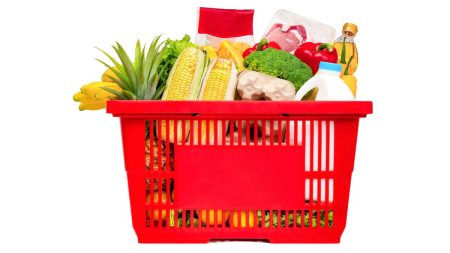Grocery shopping is a necessary part of our daily lives, but it can also be a major drain on your budget if you’re not careful. Many of us fall into habits that seem harmless but can lead to overspending. The good news is that with a little bit of planning and awareness, you can make smarter decisions at the store and save money while still feeding your family well. Below, we outline the top 10 grocery shopping mistakes that are costing you extra money and how to avoid them.
1. Shopping on an Empty Stomach
It’s a well-known fact that hunger can cloud your judgment, and this is especially true when it comes to grocery shopping. Walking into a store on an empty stomach often leads to impulse buying, especially when it comes to snacks and unhealthy food. When you’re hungry, your brain is wired to crave quick and easy foods, like chips, chocolate, and processed meals—items that may not be part of your shopping list but can significantly blow your budget.
Solution: Before you head to the store, make sure you’ve had a meal or at least a healthy snack to curb your hunger. Not only will this help you stick to your shopping list, but it will also prevent you from buying unnecessary treats that may not fit within your budget.
2. Shopping Without a List
One of the most common mistakes people make is heading to the grocery store without a list. When you shop without a plan, it’s easy to forget important essentials, and even worse, you might buy things you don’t actually need. You might find yourself making multiple trips to the store to pick up forgotten items, and that just adds to the overall expense.
Solution: Always make a list before you shop. Take a few minutes to plan out your meals for the week, check what you already have at home, and create a list of items you’ll need. This will help you stay focused and avoid unnecessary purchases.
3. Buying Processed and Convenience Foods
Processed and convenience foods may seem like a time-saver, but they often cost more than making meals from scratch. Additionally, many of these items are loaded with preservatives, unhealthy fats, and added sugars, making them not the best choice for your health. Over time, regularly buying processed food can lead to higher grocery bills without providing much nutritional value.
Solution: When possible, choose fresh ingredients and cook from scratch. It’s often more affordable, and you can control the quality of the food you’re eating. For example, buying fresh vegetables and meat and preparing meals at home will save you more than grabbing a frozen dinner or pre-packaged salad.
4. Ignoring Seasonal Produce
Seasonal produce is often cheaper and fresher than out-of-season fruits and vegetables. When you buy produce that is not in season, you’re paying a premium for the privilege of having it out of its natural growing cycle. This means you’re not only spending more but possibly sacrificing flavor and quality.
Solution: Make it a habit to check what’s in season in your area and incorporate those fruits and vegetables into your meals. Local markets or grocery stores often offer good deals on seasonal produce. Plus, you’ll enjoy better-tasting food at a lower cost.
5. Overlooking Store Brands
Many shoppers assume that brand-name products are always of better quality, but that’s not necessarily true. In fact, store-brand products are often made in the same factories as their name-brand counterparts and can be significantly cheaper. When you choose name-brand items over store brands, you may be paying for the marketing and packaging, not necessarily better quality.
Solution: Be open to trying store brands, especially for staple items like rice, pasta, and canned goods. In many cases, you won’t even notice a difference in taste or quality, and you’ll save a lot of money in the process.
6. Falling for Bulk Bargains Without Planning
Bulk deals can seem like a great way to save money, but they can quickly lead to overspending if you’re not careful. Just because an item is on sale in a large quantity doesn’t mean it’s a good deal for your household. If you buy in bulk but can’t use up the items before they expire, you’ve just wasted money.
Solution: Before you decide to buy in bulk, consider how much you’ll realistically use within the product’s shelf life. If you live alone or with just a few people, purchasing large quantities might not be the best option. For items that have a long shelf life (like canned goods or grains), buying in bulk can make sense. For perishable items, however, smaller quantities are often the better choice.
7. Skipping the Frozen Food Section
Many shoppers overlook the frozen food section, thinking fresh produce is always the best option. However, frozen fruits, vegetables, and even seafood are often just as nutritious as fresh produce—and sometimes even more affordable, especially when fresh items are out of season. Plus, frozen foods tend to last longer, reducing waste.
Solution: Don’t be afraid to shop the frozen section for your produce and protein needs. Frozen berries, spinach, and fish can be just as healthy and significantly cheaper than their fresh counterparts, and you won’t have to worry about them spoiling before you use them.
8. Wandering the Aisles and Slow Shopping
Grocery shopping without a clear goal can lead to unnecessary purchases. Wandering aimlessly down aisles or lingering in front of displays often results in buying items you don’t need or didn’t plan on purchasing. This type of shopping can significantly increase your overall spend.
Solution: Stick to your shopping list and try to move through the store as efficiently as possible. Many stores even have apps or maps that show where certain items are located. If you focus on getting what’s on your list and avoid distractions, you’ll save both time and money.
9. Ignoring Lower or Higher Shelves
Supermarkets are designed to place expensive items at eye level to catch your attention. However, the most expensive items aren’t always the best quality or value. Lower or higher shelves often contain the same products at a lower price point, and sometimes store brands, which offer better deals.
Solution: Train yourself to look at the shelves above and below eye level for alternative options. You might find a generic or store brand of the same product for a fraction of the price. This little habit can make a big difference in your overall grocery bill.
10. Not Checking Weekly Sales Flyers and Promotions
One of the easiest ways to save money on groceries is by taking advantage of sales and promotions. Stores often have weekly specials on common grocery items, and missing out on these deals can result in paying full price for things you regularly buy.
Solution: Before heading to the store, check the weekly sales flyers and any promotions your store might have. Make sure to incorporate these sales into your meal planning and buy in bulk or stock up on items that you use frequently. This will help you save big on essentials.
Check also: Best Times to Shop for Grocery and Find Marked-Down Items in South Africa
By avoiding these common grocery shopping mistakes, you can significantly reduce your grocery bill without sacrificing the quality of your meals. With a little bit of planning, mindfulness, and a few small changes in your shopping habits, you can enjoy nutritious meals and save money at the same time. Remember: smart grocery shopping is all about being aware of your choices, sticking to a plan, and not falling into the trap of impulse buying. Happy shopping!










